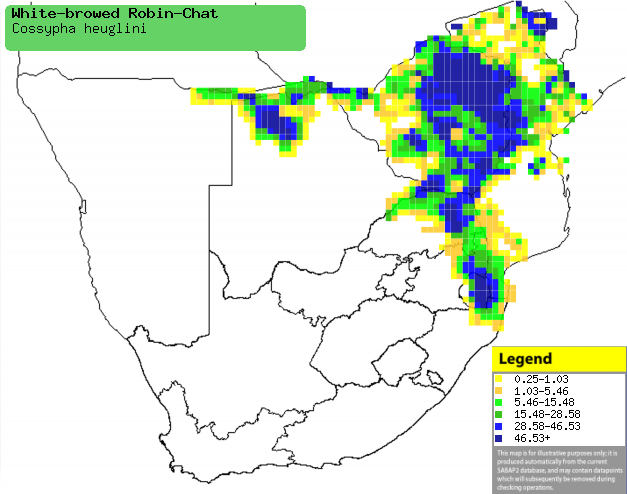|
Cossypha heuglini (White-browed
robin-chat, Heuglins robin)
Heuglinse janfrederik [Afrikaans]; Tepa [Kwangali]; Witbrauw-lawaaimaker [Dutch]; Cossyphe de Heuglin [French];
Weißbrauenrötel [German]; Cossifa de Heuglin [Portuguese]
Life
> Eukaryotes >
Opisthokonta
> Metazoa (animals) >
Bilateria >
Deuterostomia > Chordata >
Craniata > Vertebrata (vertebrates) > Gnathostomata (jawed
vertebrates) > Teleostomi (teleost fish) > Osteichthyes (bony fish) > Class:
Sarcopterygii (lobe-finned
fish) > Stegocephalia (terrestrial
vertebrates) > Tetrapoda
(four-legged vertebrates) > Reptiliomorpha > Amniota >
Reptilia (reptiles) >
Romeriida > Diapsida > Archosauromorpha > Archosauria >
Dinosauria
(dinosaurs) > Saurischia > Theropoda (bipedal predatory dinosaurs) >
Coelurosauria > Maniraptora >Aves
(birds) > Order: Passeriformes
> Family: Muscicapidae > Genus: Cossypha
Distribution and habitat
Occurs from Chad and Sudan through southern DRC, Tanzania,
Angola and Zambia to southern Africa. Here it is common from the north-eastern
corner of South Africa to Zimbabwe, Mozambique and northern Namibia and
Botswana. It generally prefers riverine forest with patchy canopy and dense
evergreen thickets, shady trees and shrubs along lakesides and Acacia
woodland on flood plains. It may also occupy thickets on the border of an open
habitat, suburban parks and gardens.
|
 |
|
Distribution of White-browed robin-chat in southern Africa,
based on statistical smoothing of the records from first SA Bird Atlas
Project (©
Animal Demography unit, University of
Cape Town; smoothing by Birgit Erni and Francesca Little). Colours range
from dark blue (most common) through to yellow (least common).
See here for the latest distribution
from the SABAP2. |
Brood parasites
It has been recorded as host of the
Red-chested cuckoo.
Food
It mainly eats insects, doing most of its foraging on the
ground, flicking through leaf litter in search of prey and occasionally gleaning
food from foliage and tree trunks. The following food items have been recorded
in its diet:
Breeding
- The nest is an open cup, the materials of which vary depending on the
habitat it is built in. It is most commonly built of dead leaves and twigs
and lined with rootlets, leaf midribs or very fine twigs. It is typically
placed in a hollow in a tree trunk, branches of a shrub or among roots under
the overhang of a riverbank.
- Egg-laying season is from August-January, peaking during November.
- It lays 2-3 eggs, which are incubated solely by the female for about
14-17 days.
- The chicks are fed by both parents, leaving the nest after about 13-17
days, after which point they conceal themselves in the undergrowth. They
become fully capable of sustaining themselves about 4 weeks after fledging.
Threats
Not threatened.
References
-
Hockey PAR, Dean WRJ and Ryan PG 2005. Roberts
- Birds of southern Africa, VIIth ed. The Trustees of the John Voelcker
Bird Book Fund, Cape Town.
|
